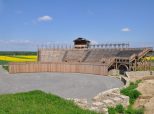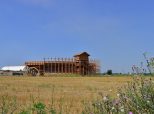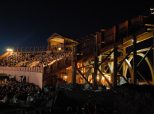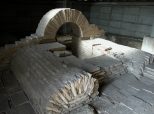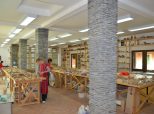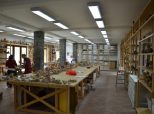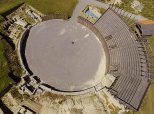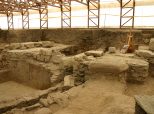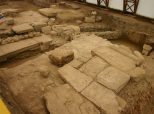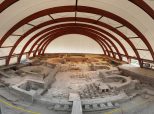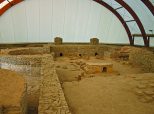Roman city and Legionary fortress
The Capital City
Villages Stari Kostolac and Drmno, 13 kilometers from Požarevac, are situated on the ruins of the antique town Viminacium, the capital of former roman province Moesia Superior. Its size and significance are due to several facts, primarily the rich hinterland in the Mlava river valley and the exceptionally convenient geographic position, both within the defense system of the northern borders of the Empire and the communication and trade network.
The town of Viminacium is founded at the territory of celtic tribe Skordisci. The settlement at Viminacium was granted municipal status during Hadrian’s reign around 117 AD, when it was given the title Municipium Viminacium Aelium Hadrianum.inacium municipium Aelium Hadrianum.
The continued development of Viminacium was briefly interrupted by an epidemic of the plague during Marcus Aurelius’ reign, but indications in the archaeological record show that the economic prosperity of Viminacium was not seriously diminished by the plague because in the early years of the 3rd century commerce was again flourishing. In the middle of 2nd century became the seat of the governor of Moesia Superior and reached its zenith by the time of Septimius Severus at the end of the 2nd century. A status of colony was obtained in the end of 239 under Gordian III (238-244). A permission to mint coins was then obtained too. According to the historical sources, in 284 a decisive battle was fought in the immediate vicinity of Viminacium for supremacy in the empire by the Emperors Diocletian and Carinus. An important survival from this period is a marble portrait of Carus’s son Carinus, which is stored in the Požarevac Museum.
There was virtually no Roman emperor who did not pass through Viminacium or spend some time there. Among visits by Roman emperors, mention should certainly be made of Hadrian’s residency when hunts were organized for him at Viminacium on two occasions; the Emperor Septimus Severus visited twice; later on other emperors stayed there: Gordian III, Phillip the Arab, Trebonius Gallus, Hostilian, Diocletian, Constantine The Great, Constans I and Julian. Gratian was the last emperor known to have visited Viminacium. In the 3rd century, during the reign of Gordian III, Viminacium attained colonial status and was granted the right to mint coins. In the 4th century, Viminacium was an important episcopal seat. In mid-5th century the city was definitively destroyed by a Hunnic attack. However, it is also possible that the city and the military camp suffered serious damage around 380 from invading Goths. The city was never reconstructed on its original location, and its revival and restoration during Justinian’s reign in the 6th century can only be conjectured on the basis of data provided by Theophylactus Simocatta and the 6th century archaeological remains at the Todića crkva site.
In the 19th century, the contours of the ancient city and military camp of Viminacium were still visible: wide streets intersecting at right angles, public squares, an amphitheater, baths, water supply conduits, city walls and towers.
Towards the end of the 19th and at the beginning of the 20th century, Valtrović and Vasić carried out archeological investigations at the Čair site on the right bank of the Mlava River, which demonstrated that the military camp had had a rectangular plan with dimensions of 1450 x 1263 ft./442 x 385 meters and that to the west of the camp there was a civilian settlement which covered an area of approximately 178 acres/72 hectares.
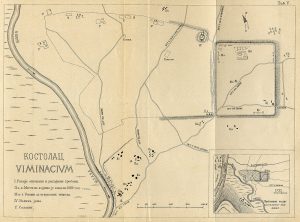
Castrum
The Roman fort (castrum) at Viminacium was built in the first decades of the 1st century AD. The existence of an earthwork fortification, although not archaeologically confirmed, was very likely built as early as the beginning of that century, and is associated with one of the first Moesian legions, Fourth Scythica or Fifth Macedonica. The erection of the first stone fortification, in the middle or in the second half of the 1st century AD, is associated with the Seventh Claudia Legion, which was based there throughout the ancient Roman period. The camp’s dimensions have been determined by geophysical methods and by analysis of digital soil sampling. They were 443 metres by 387 metres. These methods determined that the original camp was twice that size and that there is reason to believe that two legions were probably stationed there, most likely until Domitian’s edict of 86 AD. That year the order was issued that due to the threat posed to the Roman Empire, it was prohibited to station two legions at the same place. This method helped to determine the dimensions of the original camp and they are 774 metres by 443 metres. Although the Viminacium ruins were recorded as early as the 18th century by Count Marsilly, the first archaeological excavations on the site were associated with the works of Mihajlo Valtrović, at the end of the 19th century and of Miloje Vasić, at the beginning of the 20th century. Protective excavations of 1976–1997 examined the Viminacium necropolis, while systematic archaeological excavations undertaken since 2002 have initiated exploration of the Roman city and the military camp. The excavations of 2002–2003 unearthed the north gate of the legion’s camp, the so-called Porta Praetoria. The remnants of the entrance gate with massive tiling, cesspool and lavishly decorated architectural elements point to the powerful defensive system for which the camp was built on the then northern frontier of the Empire. The unearthed store of bronze coins dating back to the beginning of the 4th until the middle of the 5th centuries AD indicates the time of the destruction of the camp which, after the Hun invasion in 441 AD was abandoned and had never since been restored to its former glory. Aerial pictures, as well as geo-radar and geomagnetic filming carried out on the site of the former castrum, provide a true picture of the camp with its ramparts, gates, turrets, the legion’s headquarters and barracks lying beneath the fertile cultivated fields of Stig.
